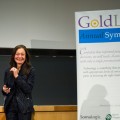Joy Hirsch, Ph.D., is a neuroscientist and currently a Professor of Psychiatry and Neurobiology at Yale University, in New Haven, CT. She has pioneered many breakthroughs in understanding the workings of the human brain, and is one of the early developers of functional magnetic resonance imaging (fMRI), an imaging technique that enables the visualization of individual brain structures and large-scale neural networks that are engaged during specific tasks and cognitive processes. She has recently been recruited to Yale University to head a new Brain Function Laboratory leaving her previous position as Professor of Neuroscience at Columbia University where she was the Director and founder of the university-wide Functional MRI Research Center.
Her research on the human brain has focused on understanding principles of the relationships between the brain, mind, and behavior, and the translation of these advances to serve many medical applications. Examples of applications include the development of brain mapping procedures for neurosurgical planning that localize regions of brain specialized for important functions such as language, movement, vision, and hearing in order for neurosurgeons to protect those functions during procedures such as tumor resections. Her basic research has also made fundamental contributions to understanding the neural processes that mediate emotion such as fear and conflict and the control of those responses. These studies form the foundation for her continuing research interests in translations to medical conditions such as understanding the basis for anxiety disorders and treating strategies. Her research also includes clinical applications such as the development of an imaging diagnostic for autism (a recently issued U.S. patent), and isolation of neural mechanisms associated with obesity.
Professor Hirsch has published over 120 peer-reviewed scientific papers and chapters, is a popular world-wide lecturer on the brain, and served as a curator for the 2010-2011 Brain Exhibit at the American Museum of Natural History. She was awarded the prestigious Gamow Science prize in 2009 for her accomplishments in science and was one of the five top women scientists featured in the 2011 World Science Festival.
More information on her web site: www.fMRI.org














